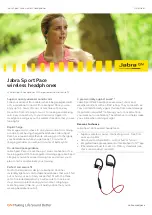Summary of Contents for Active
Page 1: ... Active Active Pro Active Charger User Guide ...
Page 5: ...5 Important information 98 Conformance information for charger 98 Service and warranty 102 ...
Page 16: ...16 Features The tinnitus therapy feature generates a sound to distract you from your tinnitus ...
Page 100: ...100 ...
Page 101: ...101 ...
Page 103: ...103 Warranty Date of purchase Warranty period in months Your Hearing Care Professional ...

















































